The MINI Harman Kardon Stereo System
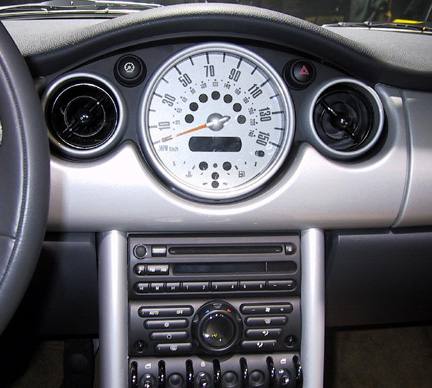 MINI Center Stack Because there has been some controversy and apparent misunderstanding of the nature of the upgrade H/K audio system offered by MINI on the 2003-2006 models, I thought it might be useful to explain some of the features and the apparent design philosophy behind the system for users and prospective purchasers of the system. I suppose the situation is only exacerbated by the scant information in the MINI stereo manual. As a recording engineer by trade, I have worked for years with Harman Kardon and Harman Group professional equipment and have developed a respect, and a certain trust, for their products. Given that, I stuck out my neck and ordered the H/K stereo sight-unseen. I, for one, wasn’t disappointed. After listening to and analyzing the system, here are my observations. Please understand that all the information contained in this document was acquired through “reverse engineering”, meaning the information came from listening to and experimenting with the system, rather than from Harman Kardon. Where the heck is the manual that should have come with this thing? 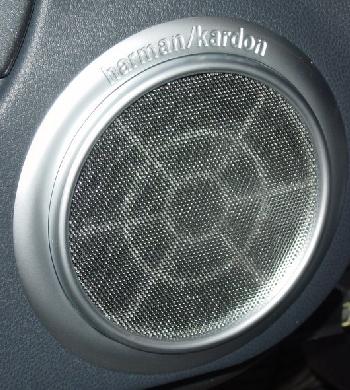 H/K Front Mid Driver DEFINITIONS Everyone goes into a stereo purchase with his own expectations. Let’s define some terms to make things easier to discuss: Imaging: How we perceive or “visualize” the physical location of individual sounds in a program. Different designers approach imaging with different philosophies, two of which follow: Point source: One end of the imaging philosophy spectrum preferring an ability to easily pinpoint the physical locations of particular sounds in a program. Diffuse Field: The other end of the imaging philosophy spectrum preferring to spread sounds throughout the listening area to make them fill the space and sound “bigger”. Flat response: Uncolored reproduction. Reproducing all frequencies within a program at the same loudness level. In the real world this isn’t possible but it is one goal for which some manufacturers strive. EQ: Equalization. A tool designed to make a sound system reproduce all frequencies at the same volume level and reproduce uncolored sound. The moment an equalizer got into a user’s hands, it also became a creative sound-shaping tool, allowing the user to color the sound to his tastes. It’s a little bit of audio democracy. Hollywood Curve: A frequency-response coloration that adds volume at the low and high ends of the frequency range to make a program sound more exciting. “Loudness” Contour: A circuit designed to be used while listening at low levels which superimposes a curve similar to the Hollywood Curve onto a signal to compensate for the ear’s reduced high and low-end response at low listening levels. PHILOSOPHY AND INTRO Now that we are all talking the same language, lets dive into the apparent design philosophy of the H/K stereo and learn to match its capabilities to our expectations. The Harman Kardon Stereo system available for the MINI has been specially designed to acoustically compliment the interior of the MINI. Armed with a little information, the user can choose from a variety of combinations of sound dispersion patterns and broad frequency response curves to suit his needs. The apparent design goals for the MINI H/K were: 1) To create an extremely high-quality audiophile-type sound system 2) To create a moderately high-powered sound system. 3) To create a system with the flexibility to handle differing music, listening situations, and tastes. 4) To create a system which takes up no more precious user space in the car than the base-level system. In order to achieve these goals, the system is built around a ten-channel amplifier/preamp module that hides in the right-rear trim panel of the boot, 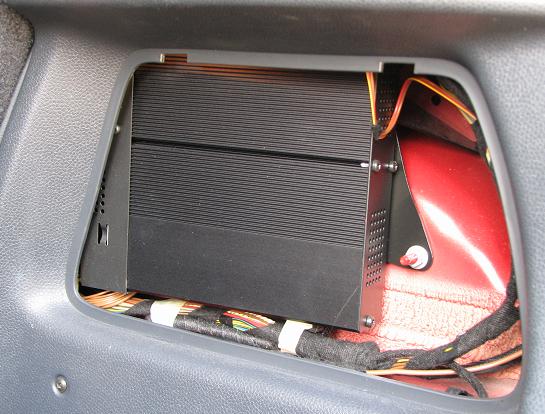 H/K Preamp/Amp/DSP Package a digital signal processing (DSP) preamp (contained in the amp), and eight high-quality speaker elements, some of which are dual-tasked. There were some compromises, but there always are. The DSP system is controlled by menus within the “Boost” head unit that is standard in the U.S. and an upgrade in the UK. The H/K system provides for both Point Source and Diffuse Field dispersion patterns with its menu-selected MODES. It also provides a mode that allows front and rear-seat passengers to hear roughly the same sound. I should mention that there are also diverse philosophical approaches to frequency response in stereo design. The two ends of the philosophical spectrum are represented by: 1) Attempts to create the most flat and neutral reproduction system possible, and 2) Creation of a system which “flatters the music” by deliberately adding and subtracting volume at various frequencies in order to create a rich, “bigger than life” sound. The H/K system caters to both, providing a fairly flat mode and some colored modes to allow the system to appeal to differing tastes. Due to my profession, you can probably guess which type of system I prefer. At home and in the car, I like for my stereo systems to be fairly flat but have just a tad more bass and treble (a slight Hollywood Curve) because those additions flatter most music. 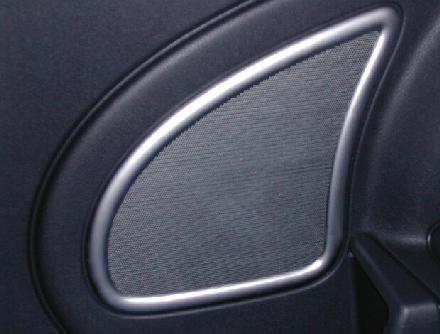 H/K Rear Driver OPERATIONAL NOTES As a starting point it would be wise to choose the dispersion pattern you desire. First set the MODE to achieve this pattern and then tweak the EQ to your tastes. Descriptions of each of the modes follow. Because each of the modes features its own frequency response curve, it is likely you’ll want to tweak the EQ after you change modes. The reasons for this will be obvious in a moment. As you may already know, the Boost head unit, which is used to control the H/K system, offers individual tone settings for each input to the system (Radio/CD/CD changer, etc.). On a side note, the “Tone Lin” feature neutralizes all the EQ settings you’ve tweaked up so nicely in one “fell swoop”, by resetting the EQ controls to their middle position. Be careful! SPACIAL CONSIDERATIONS Point Source If you wish to preserve the spacial integrity of the stereo signal, you should use the “H/K MINI”, “Electronic”, and “Instrumental” modes. These modes use the rear speakers as woofers and sub-woofers, and the front systems as full-range drivers. The result is a front stereo soundstage with exceptional left to right imaging and tonal clarity and strong, deep, and clear bass response reinforced from the back. Because bass frequencies are much less directional than mid and high frequencies, from the front seats the bass is not perceived as coming from the back. Because the MINI interior is fairly small and because mid and high-frequency sounds reflect from hard surfaces, as volume comes up, the mids and highs spread throughout the cabin pretty well. At lower levels, however, the back seat passengers may not hear much mid or high-end sound. The Point Source programs offer a further spacial enhancement, “Driver”. By employing minute delays and volume adjustments, “Driver” setting optimizes the soundstage for the driver, simulating the sound you would hear when seated centered between the speakers. To my ears, it also appears to collapse the sound field a little towards the center. You will have to decide if you like this mode for yourself. Diffuse Field If you wish to spread the sound around the cabin and create a “wash” of sound which surrounds you, or if you will be carrying passengers in the back who care about the quality of the sound, select the “Spacial” mode. This mode uses the two rear speaker systems as full-range systems and thus presents to the back and front similar material. Similar, but different, because the frequency response of the two systems is different. “Spacial” mode provides the basic four-speaker car stereo array with enhanced spacial spread added by surfing the tone differences between the front and rear speakers. To demonstrate this, with the car parked, the stereo playing, and you in the driver’s seat, turn your head to the right and look out the passenger window. You should be able to hear the front-to-rear spread. You’ll probably notice a little drop in bass and lower-midrange frequencies in this mode as the rear speakers are used as full-range systems. You can, however, adjust the frequency response of the system with the front-to-rear fader. “Festival” mode blends delays into the front speakers and sends a reduced front signal plus reverb to the rear speakers to create a “concert hall” type of sound. You can hear the delays when transient sounds are played. During the silence while changing CD tracks you can hear the reverb ring out in the rear speakers. Oh, wow, man. 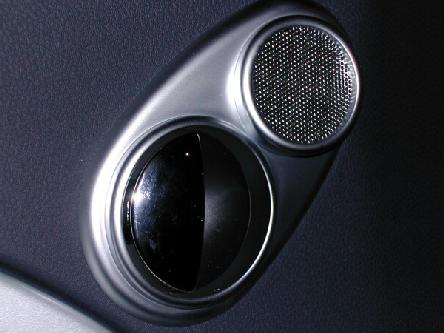 H/K Front Tweeter and Door Latch POINT SOURCE MODES AND TONE Each of the point source modes offers a slightly different response curve. Of the Point Source Modes, “H/K” provides a smooth and open midrange sound with solid bass and crisp treble that makes it excellent for vocal music and a good starting point in experimenting with EQ curves. It also has a very natural but full bass response with plenty of dynamic range. As you raise the volume, the bass becomes more and more solid. Don’t be surprised if you find yourself adding a little treble. The better the recording, the better it will sound in this mode. Break out the wine and cheese, this mode has “audiophile” written all over it. On the other hand, “Electronic” mode applies a generous Hollywood Curve, much like switching in a “Loudness” contour. Those who listen at lower levels may find this compensates for the ear’s non-linearity down there. At louder levels, you’ll find thick bass and sharper highs. Do you have any recordings that are weak in the bass and treble? Remember the ‘60s and early ‘70s? If so, were you really there? How about the boxy, electronic ‘80s? “Electronic” can make them sound more alive by bringing out the cymbals, bass, and kick drum. Make it jump off the speakers, man. “Instrumental” mode seems designed with classical music listeners in mind, with very little “hype” and very flat response as its hallmarks. This lack of hype allows you to jack up the volume to hear low-level passages with little fear that a sudden swell will blow the speakers out of your doors. A recording that is too brittle on the high-end and too boomy in the bass can be mellowed out by this mode. The flat response will also minimize the little irritations classical recording can manifest (hall rumble, string razz from the violins, page turns). This would also reduce the problems in those PBS classical broadcasts. Put on your black tie and enjoy. 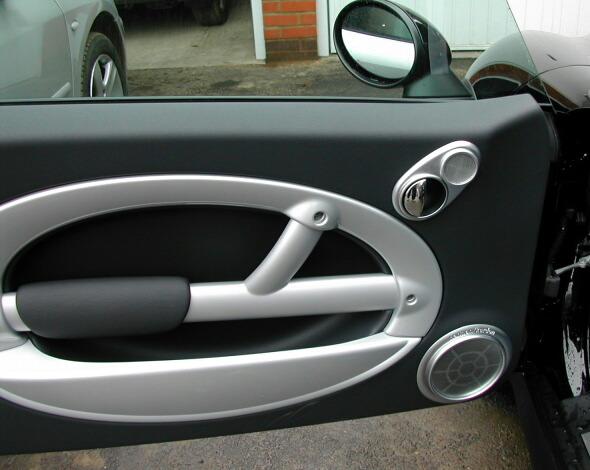 MINI Driver's Door With H/K Components WHOOP-TEE-DOO! WHAT DOES IT ALL MEAN, BASIL? If you are looking for an earth-shaking, modern, extremely high-powered system designed for hip-hop, and you plan to run it at 110db or above, maybe this isn’t the system for you. If you are looking for the type of system that can be heard from within your living room as a car passes out on in the street, this possibly isn’t the system for you. If you are looking for an “attack” system that can be leveled on the other motorists around you at stoplights, this probably isn’t the system for you. That isn’t exactly “Motoring”. Do I sense an attitude from the author here? Sorry. At any rate, those systems typically need a separate sub-woofer, which takes up extra space in the foot well or boot, space that is at a premium in our MINIs. If you are hoping to have a system with four similar-sounding speaker locations, this may not be the system for you. If, on the other hand, you are looking for a reasonably powerful, musical, wide-range stereo, one which can be configured to optimize the front seat listening experience or provide music for all, this might just be the system for you. If you enjoy “audiophile” stereo systems at home, this may just be the system for you. If you don’t want to loose foot room or trunk space and want to keep the nondescript (though excellent) Boost front-end unit to deter theft, this might just be the system for you. Also remember, when installed at the time of purchase, this stereo is also covered for the duration of the MINI’s warranty. As in most things audio, the final result is very subjective. Some will love this system, some will hate it. You’ll want to go down to a MINI dealer with your favorite disks in your hand and ask to spend an hour with a Harmon Kardon-equipped car to find out. You can listen with the car turned off, but the system will automatically shut down every twenty minutes. Just turn it back on. Bon appetite! Point Source modes with “Driver” feature available: Name.............Sound....................................Notes H/K MINI.........Gentle Hollywood Curve.........Rear speakers used as subs Electronic.......Generous Hollywood Curve....Rear speakers used as subs Instrumental....Flat response..........................Rear speakers used as subs Diffuse modes: Name.............Sound....................................Notes Spacial...........Gentle Hollywood Curve........EQ and slight delay (?) to rear Festival..........Gentle Hollywood Curve.........Delays in front and reverb to the rear Go HERE for a great album to demonstrate the Harman Kardon stereo. Click HERE for a printable version of this review in HTML format and HERE for a printable version in WORD format. Click HERE to visit the rest of my MINI page. UPDATES: (Feb. 17, 06) Others have mentioned and I can confirm that the system calculates the total power going to the speakers and limits output to prevent speaker burnouts and distortion. As a result, if you dial up extra bass or treble while you have the volume up very loud, the system will drop the top level to allow the added, localized gain without damaging the speakers. (Aug 28, 03) It has recently been brought to my attention that the MINI H/K has what I call a "Marriage Saver" feature: Have you ever dragged yourself out of the sack and into the car for a 5:15am early shift? Do you know what a good stereo, accidentally left on at high volume from the night before, can do to your fragile psyche at that time of morning? Have no fear, the MINI H/K takes care of that for you. If you leave the volume up high and switch it off, the system resets itself to a more moderate level at startup. I was wondering why my wife never complained that I left the thing set too loud...  Imden Wireless Unit (October 03, 2020) A viewer asked about integrating a cell phone into the H-K radio. I've managed to integrate my iPhone with the unit with the help of a wireless connection kit. It isn't perfect but is pretty good. I can listen to music, receive calls, and follow Google Maps' voice directions as needed. The unit is an Imden Wireless Hands-free Car Kit from AMAZON. At $17.95 it is worth a try. A friend at work reccommended the unit and it turned out okay. You'll need to turn up the treble on the H-K a bit. The phone communicates to the unit via BlueTooth and th unit communicates with the radio over an empty FM channel that you select. It pairs up automatically when you turn on the car each time. Power comes from the cigarette lighter socket. Voile'!
My New MINI Homepage: CLICK HERE
|